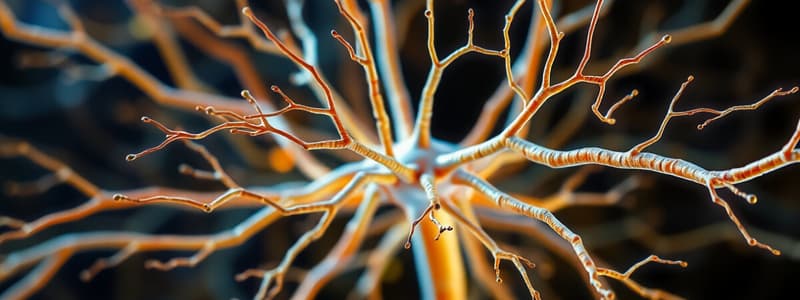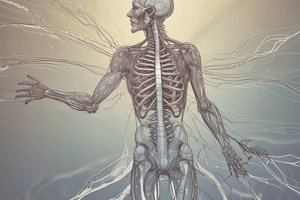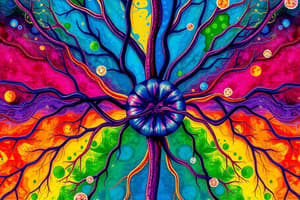Podcast
Questions and Answers
What is the primary function of a synapse in neural communication?
What is the primary function of a synapse in neural communication?
- To maintain structural integrity of the neuron
- To store electrical impulses for later use
- To enable the release and reception of neurotransmitters (correct)
- To facilitate direct electrical connection between neurons
Which neurotransmitter is primarily associated with mood regulation?
Which neurotransmitter is primarily associated with mood regulation?
- Dopamine
- Acetylcholine
- Norepinephrine
- Serotonin (correct)
What component is NOT found in the structure of a synapse?
What component is NOT found in the structure of a synapse?
- Postsynaptic receptor
- Synaptic cleft
- Myelin sheath (correct)
- Presynaptic terminal
Which neurotransmitter is primarily involved in muscle contraction?
Which neurotransmitter is primarily involved in muscle contraction?
What distinguishes neurotransmitters from hormones?
What distinguishes neurotransmitters from hormones?
What is the primary role of dendrites in a neuron?
What is the primary role of dendrites in a neuron?
What distinguishes a synapse from other parts of a neuron?
What distinguishes a synapse from other parts of a neuron?
How do nerve impulses cross the synaptic gap?
How do nerve impulses cross the synaptic gap?
What is the role of the myelin sheath in neuron function?
What is the role of the myelin sheath in neuron function?
Which of the following statements about the structure of a neuron is accurate?
Which of the following statements about the structure of a neuron is accurate?
What is the approximate minimum number of unique neurotransmitters that have been identified in humans?
What is the approximate minimum number of unique neurotransmitters that have been identified in humans?
Which of the following classifications does NOT describe how a neurotransmitter influences a neuron?
Which of the following classifications does NOT describe how a neurotransmitter influences a neuron?
Which statement about neurotransmitters is accurate?
Which statement about neurotransmitters is accurate?
What common feature do excitatory, inhibitory, and modulatory neurotransmitter influences share?
What common feature do excitatory, inhibitory, and modulatory neurotransmitter influences share?
Which of the following is a characteristic of neurotransmitter function?
Which of the following is a characteristic of neurotransmitter function?
What does it indicate if a neurotransmitter is classified as modulatory?
What does it indicate if a neurotransmitter is classified as modulatory?
Which of the following is classified as an excitatory neurotransmitter?
Which of the following is classified as an excitatory neurotransmitter?
Which neurotransmitter is primarily associated with inhibition?
Which neurotransmitter is primarily associated with inhibition?
Which of the following neurotransmitters is considered a neuromodulator?
Which of the following neurotransmitters is considered a neuromodulator?
What defines a neurohormone?
What defines a neurohormone?
Identify the combination that includes only inhibitory neurotransmitters.
Identify the combination that includes only inhibitory neurotransmitters.
Flashcards
Synapse
Synapse
A junction between two neurons, where a signal is transmitted from one neuron to the next.
Neurotransmitters
Neurotransmitters
Chemical messengers released by neurons that transmit signals across the synapse.
Excitatory Neurotransmitter
Excitatory Neurotransmitter
A type of neurotransmitter that promotes the firing of nerve impulses, increasing the likelihood of an action potential.
Inhibitory Neurotransmitter
Inhibitory Neurotransmitter
Signup and view all the flashcards
Serotonin
Serotonin
Signup and view all the flashcards
Neuron
Neuron
Signup and view all the flashcards
Dendrites
Dendrites
Signup and view all the flashcards
Cell body
Cell body
Signup and view all the flashcards
Axon
Axon
Signup and view all the flashcards
Excitatory
Excitatory
Signup and view all the flashcards
Inhibitory
Inhibitory
Signup and view all the flashcards
Modulatory
Modulatory
Signup and view all the flashcards
How many neurotransmitters?
How many neurotransmitters?
Signup and view all the flashcards
Neurotransmitter effects
Neurotransmitter effects
Signup and view all the flashcards
What is an excitatory neurotransmitter?
What is an excitatory neurotransmitter?
Signup and view all the flashcards
What is an inhibitory neurotransmitter?
What is an inhibitory neurotransmitter?
Signup and view all the flashcards
Define a neurotransmitter.
Define a neurotransmitter.
Signup and view all the flashcards
What is a neuromodulator?
What is a neuromodulator?
Signup and view all the flashcards
Glutamate is an example of what type of neurotransmitter?
Glutamate is an example of what type of neurotransmitter?
Signup and view all the flashcards
GABA is an example of what type of neurotransmitter?
GABA is an example of what type of neurotransmitter?
Signup and view all the flashcards
Study Notes
Central Nervous System & Neurotransmitters
- The nervous system controls bodily functions and reactions to surroundings.
- The nervous system has components such as the brain, spinal cord, spinal nerves, and specialized sense organs.
Nervous System Outline
- Define the nervous system
- List components of nerve cells, describing their function
- Describe synapse and its components
- List different neurotransmitters and their functions
Introduction
- Living organisms react to environmental changes (stimuli).
- A response to a stimulus is called a response.
- Responsiveness is also known as sensitivity or irritability.
Sense Organs
- Sense organs detect stimuli and are also called receptors.
- They transmit electrical signals (nerve impulses) to the central nervous system.
- Sense organs help the body adjust to environmental changes.
- They allow body parts to coordinate.
- Sense organs include smell, sight, touch, taste, and hearing.
Nerve Impulses
- Nerve impulses are electrical messages transmitted through the peripheral nervous system to the central nervous system.
- Sensory nerves carry signals from the receptors to the spinal cord.
- The spinal cord carries signals to motor nerves for movement.
Neurotransmitters
- The human body has around 1 trillion nerve cells.
- Around 100 chemicals (neurotransmitters) transmit messages between nerves.
Nervous System Components
- The central nervous system consists of the brain and the spinal cord.
- The peripheral nervous system encompasses nerves and sensory structures located outside the brain and spinal cord.
- The peripheral nervous system is further subdivided into the somatic and autonomic nervous systems.
- The somatic system controls voluntary muscle actions.
- The autonomic system controls involuntary processes (e.g. smooth muscle, glands) and is further divided into sympathetic and parasympathetic systems.
- Sympathetic ("fight or flight")
- Parasympathetic ("rest and digest")
Nervous System Cells (Neurons)
- Neuron structure fits its function: many entry points for signals; one path out; transmits signals
- The neuron has: dendrites, cell body, axon; myelin sheath; synaptic terminal; synapse
Parts of a Neuron
- Nucleus: controls the entire neuron.
- Dendrites: receive signals from other cells.
- Cell body: organizes and maintains the cell's function.
- Cell membrane: protects the cell.
- Axon Hillock: generates the impulse in the neuron.
- Axon: transfers signals to other cells and organs.
- Myelin sheath: increases signal speed.
- Axon terminal: forms junctions with other cells.
- Node of Ranvier: allows diffusion of ions.
- Schwann cell: produces the myelin sheath.
Synapse
- A synapse is a junction between two neurons (or a neuron to an effector like muscle or gland).
- Nerve impulses are transmitted across the synaptic gap via chemicals called neurotransmitters.
Neurotransmitter Discovery
- Until the early 20th century, it was thought that communication in the brain was entirely electrical.
- Otto Loewi discovered acetylcholine (ACh), the first known neurotransmitter.
Neurotransmitters (Function)
- They transmit a message across the synapse to a target cell.
- Released from synaptic vesicles into the synaptic cleft.
- They bind to receptors on the target cell.
- The exact number of neurotransmitters is unknown, but over 200 are identified.
Neurotransmitter Effects
- Neurotransmitters can be excitatory, inhibitory, or modulatory.
- Excitatory neurotransmitters (e.g., glutamate) increase neuronal activity.
- Inhibitory neurotransmitters (e.g., glycine, GABA) decrease neuronal activity.
- Modulatory neurotransmitters (e.g., neuropeptides) influence the sensitivity of neurons.
Key Neurotransmitters & Their Functions
- A number of key neurotransmitters play specific roles, including those shown on the table.
Neurotransmitter Classification
- Neurotransmitters are classified into categories like Amino Acids, Monoamines, Catecholamines, Indolamines, Soluble Gases, and Neuropeptides.
Neurotransmitter Identification Criteria
- Four main criteria to identify neurotransmitters:
- Chemical must be synthesized or present in a neuron.
- Chemical must be released upon neuron activation, triggering a response in targets.
- The same response should occur when the chemical is experimentally placed on the target.
- A mechanism to remove the chemical from the activation site must exist.
Examples of Neurotransmitters & Functions
- Adrenaline (fight or flight)
- Noradrenaline (concentration, attention, blood vessel contraction)
- Dopamine (pleasure motivation, movement)
- Serotonin (well-being, mood, sleep cycle regulation)
- GABA (calming, motor control)
Acetylcholine Functions and Deficiency
- Acetylcholine (ACh) is crucial for movement, heart rate, and memory.
- It works through muscarinic and nicotinic receptors.
- Deficiency in ACh can affect memory, cognition, and muscle function.
Foods Rich in Choline
- Foods with high choline content support ACh production.
Improving Acetylcholine Levels
- Lifestyle changes can influence ACh levels. (e.g. stress management, blood sugar levels, strategic caffeine use).
Impacts of Decreased or Increased Neurotransmitter Production
- Neurotransmitter imbalances can lead to various disorders (e.g., Parkinson's Disease, schizophrenia).
- Parkinson's: low dopamine leading to motor control issues
- Schizophrenia: possible unusually high dopamine.
Studying That Suits You
Use AI to generate personalized quizzes and flashcards to suit your learning preferences.
Related Documents
Description
Test your knowledge on the central nervous system and neurotransmitters. This quiz covers the definitions, components, and functions of nerve cells and neurotransmitters, along with the role of sense organs in responding to stimuli. Challenge yourself with questions related to nerve impulses and their significance in bodily functions.




